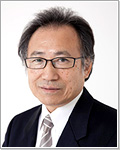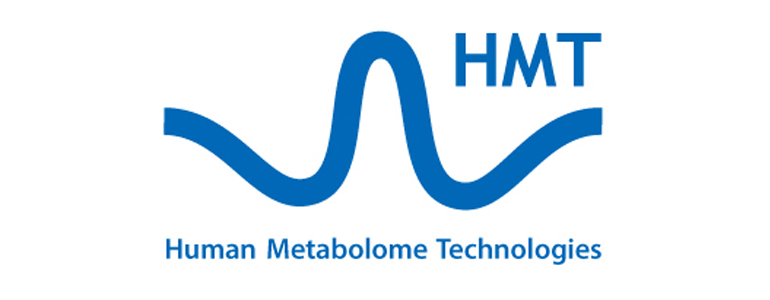| Human Metabolome Technologies (6090) |
|
||||||||
Company |
Human Metabolome Technologies Inc. |
||
Code No. |
6090 |
||
Exchange |
Mothers of Tokyo Stock Exchange |
||
Industry |
Service Industry |
||
President |
Ryuji Kanno |
||
Address |
246-2 Mizukami, Kakuganji, Tsuruoka-city, Yamagata |
||
Year-end |
End of March |
||
URL |
|||
*Share price as of closing on the end of June 17. Number of shares outstanding is as of March 31.
ROE and BPS are based on actual results of the previous term end.
|
||||||||||||||||||||||||
|
|
*Forecasts are those of the Company.
|
|
| Key Points |
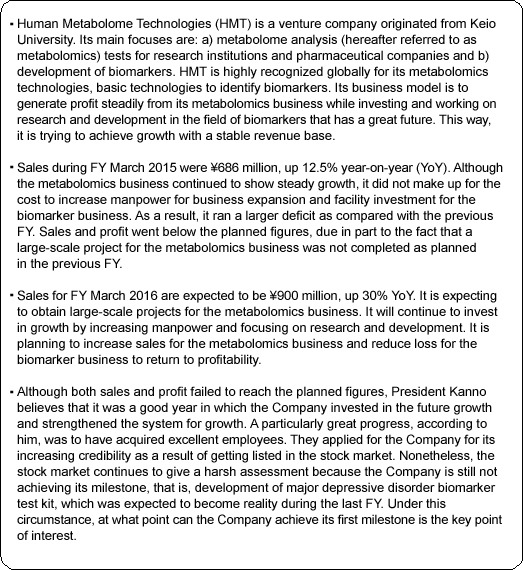 |
| Company Overview |
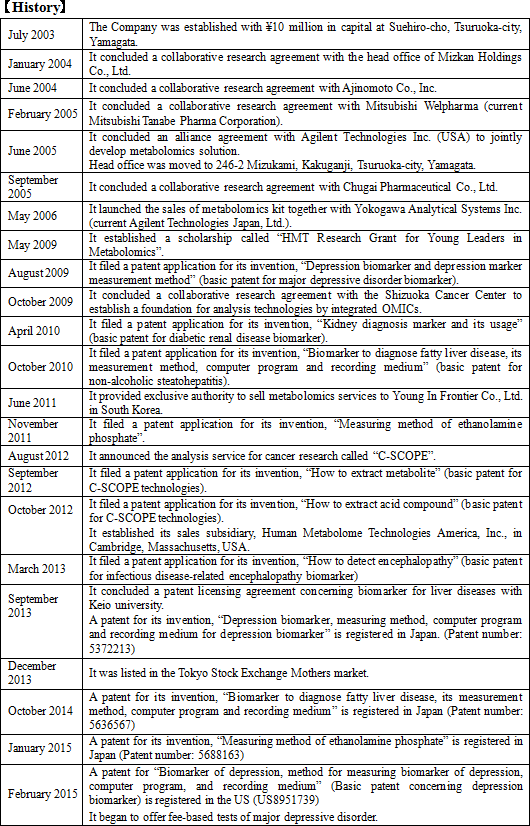 The metabolomics technologies had been used for various purposes such as fundamental biological research, development of pharmaceutical products, disease biomarkers, etc., and the technologies were expected to be in increasingly high demand in the future. Therefore, upon establishment of the CE-MS method, HMT was established in July 2003 to commercialize the method chiefly by Professor Soga, Professor Masaru Tomita, also from Keio University, and Keio University itself. It was the first venture company originated from Keio University, with a financial support from Keio University's entrepreneurship fund. In 2008, Mr. Ryuji Kanno became the president of the Company. Before taking up this position, Mr. Kanno was Vice President & CEO of Agilent Technologies Japan, Ltd., a Japanese subsidiary of Agilent Technologies, a global company that develops, manufactures, sells, and supports chemical analysis equipment and electric & electronic measurement equipment in the field of life science. Agilent Technologies Japan, the subsidiary, had been for sometime in business relationships with HMT and Keio University. President Kanno promoted research and development of the Company's core technologies and also began organizing and establishing more specific commercialization process and business models. At the same time, he began preparation for the Company to be listed on the stock market in order to accelerate its growth speed through enhancing the Company's visibility and raising funds for research and development. The Company got listed on the Mothers Section of the Tokyo Stock Exchange in December 2013, ten years after its establishment. "To contribute to health and joyful lives of people through research and development using the latest metabolomics technologies for the children in the future." The Company also sets the following 5 "Common Values. 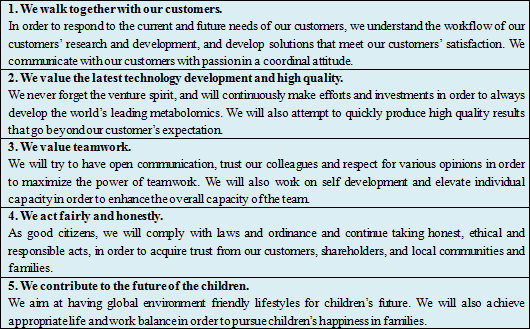 To help understand the Company's business, 3 points are briefly provided here. (1) Significance of social presence
Biomarkers are in vivo substances that are used as indicators to measure the current state of specific diseases. The well-known biomarkers include "blood sugar" for diabetes, "γ-GPT" for liver function disorder, and "uric acid" for gout. The Company discovered a biomarker for "measure depressive disorder", one of current major social issues, and is developing diagnostic agents to quantify the condition of the disease. Because there is no prevailing method to objectively measure the status of depression although the number of patients of depression is increasing, some serious problems are emerging regarding to the therapy of depression. For example, patients who would have been cured if they had treated right are still suffering or in overprescription. If the diagnostic agents using the Company's biomarker become to be widely used, these issues are expected to be solved, and social loss will be subsequently reduced. This social significance cannot be overlooked to understand the Company. (2) Excellent technological capacities
The "metabolomics technologies" refers to technologies to examine behavior of complicated human body and identify biomarkers. The Company is highly recognized for these technologies in the world. The biomarker for major depressive disorder is just an example. With the metabolomics technologies, the Company is expected to identify and develop various new biomarkers in the future. (3) Stable business model
The Company's current core business is the "metabolomics business" that occupies about 80% of its sales. It is a business to support research and development activities of research institutions and pharmaceutical companies. Sales of FY March 2015 were 566 million (up 9.7%, YoY) and operating income was 313 million (up 0.9%, YoY), showing steady income. On the other hand, the "biomarker business", which is expected to achieve significant growth in the mid- to long-term, is still operated in a small scale and experiencing losses. However the Company has already established a balanced business model, in which the profit generated from the metabolomics business is invested into the biomarker business for its growth. This model is notable among many bio-venture companies that are suffering from gaining profit. ◎What is depression?
Depression is a type of mood disorders and is a brain dysfunctional state for various reasons such as accumulated physical and mental stress. Because the brain is not functioning properly, people in the depressed mood can feel negative and low-esteem. This causes vicious cycle in which people with depression feel more stress for the matters that they could otherwise handle. The "major depressive disorder" refers to the state in which depression mood continues even after the sources of stress are removed. In this regard, it is distinguished from adjustment disorders or some anxiety disorders, and is considered a brain dysfunction, instead of a mere response to stress. (Note: "Major" of the major depressive disorder means "primary" and does not mean "serious" depression.) ◎Number of depression patients in Japan
According to the "Patient Survey" conducted by the Ministry of Health, Labor, and Welfare (MHLW) every three years targeting health facilities across the country, the total number of patients with mood disorders including depression increased from 430,000 in 1996 to 950,000 in 2011 (2.2x).The "Patient Survey" shows statistical data of the number of patients who visit health facilities. It is known that the consultation rate of patients with depression is low. Thus, according to the MHLW, it is suspected that the actual number of depression patients might be larger. 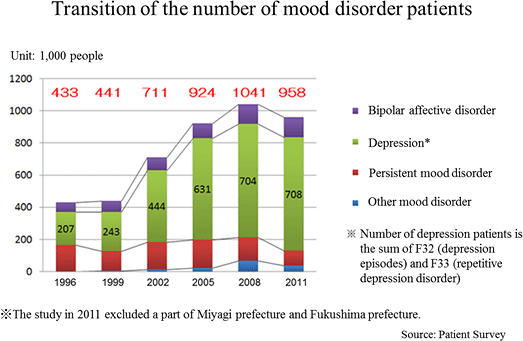 It is unfortunate to have depression for the patients and their families. Depression is also a significant social issue, due to its negative effects on productivity of the organization such as company that the patients belong to, or its social impact caused by suicide. ◎Treatment of depression
If someone is diagnosed as having depression, the common treatment is prescription of "antidepressant drugs." The antidepressant drugs can be categorized into several groups such as selective serotonin reuptake inhibitor (SSRI), serotonin-noradrenaline reuptake inhibitor (SNRI), and tricyclic antidepressant. In addition, anti-anxiety drugs or sleep inducing drugs can be used, depending on the symptom. Under drug therapy, patients are provided with explanation of the effects and side effects of the prescribed drugs, and it is important for the patients to comply with the prescribed amount and frequency. However, patients with depression often reduce the amount or frequency without doctors' permission for some reasons such as they do not feel the symptom to be very serious or they worry the side effects. In these cases, the patients do not show improvement as doctors expect, and the doctor prescribe more drugs or change the types of drugs. That would often result delay in recovery or excessive administration of drugs, for lack of trust between doctors and patients. Therefore, it is essential to have objective assessment standards quantifying the state of depression or proving the depression has been cured. The biomarker and diagnostic agents of the major depressive disorder that the Company is currently working on are extremely important for prompt and appropriate treatment of the disease. <What is metabolomics?>
Living organisms including human beings are consisted of organs such as muscles, internal organs, and bones with various functions. The common components of these organs are called "metabolites" such as amino acids, fatty acids and nucleic acids. The metabolites play a crucial role for entire life activities. The metabolites are provided by food and are consumed in the process of daily actions such as exercise. They move within body or cell in accordance with their functions, and are converted into new substances through various chemical reactions. These chemical reactions are called "metabolism". Adjusting body temperature, breathing, moving heart, digesting and absorbing food, transforming old cells into new ones are all done by metabolism. The "substance conversion" to a new substance is based on a certain rule called metabolic pathway. A well-known approach to understand the structure and mechanism of a human body is "genomics", analyzing genes. As of now, automated sequencing and computer analysis of genetic information (DNA base sequences) is possible, and nearly all the information in the human genome has already been deciphered. However, much about the relationship between the roles of genes and diseases remains unknown. Recently researchers tend to believe that it is necessary to investigate metabolites, instead of just gene information by genome analysis, to understand the relationships between human body and diseases. Therefore, research and use of "metabolomics (metabolome analysis)" targeting all metabolites is becoming increasingly popular.  <What are biomarkers?>
Human body has a function called "homeostasis". It is a system to control various functions in details, minimize internal and external influences and keep body conditions stable. Body temperature or heartbeat may change temporarily but return to regular temperature or beat. These are some examples of "homeostasis". Diseases can cause abnormality in homeostasis and affect metabolites, which would create a status unlike a healthy one. These metabolites are called biomarkers. By measuring a biomarker, the current status of a specific disease can be objectively assessed. Well-known biomarkers include blood sugar as a pancreas function indicator, γ-GTP as a liver function indicator, biomarker PSA for prostatic cancer and biomarker CA19-9 for pancreatic cancer. Biomarkers have been studied for a long time in order to monitor the status of diseases. These days, with new methods to analyze multiple substances with higher sensitivity all at once, study results of various new biomarkers have been publishing one after another. Among the biomarkers that are explored through metabolomics technologies are the followings:  It is trying to expand the metabolome study into related market by disseminating the excellence of CE-MS method, which is the foundation technology, for research institutions and pharmaceutical companies, and securing income base by expanding the metabolomics business within Japan and overseas. Meanwhile, the Company is investing the income gained from its currently major business, "metabolomics business", into the research and development of the growing business, "biomarker business". It is aiming for mid- to long-term growth through practical application of intellectual properties gained from the biomarker business in the fields of pharmaceutical products development and disease diagnosis. The profit making structure and customers of each business are as follows.  (1) Metabolomics business
The Company's customers include private companies such as pharmaceutical companies and food companies as well as universities and public research institutions. They order the Company's service to conduct metabolomics tests. "Sales were ¥ 566 million and operating income was ¥ 313 million for FY March 2015." The customers send the samples to the Company for analysis. The Company extracts metabolites from the samples and conducts metabolomics tests, etc. using the CE-MS method. After that, it sends the report including the test results to the customers. The metabolite data obtained from the metabolomics service are used for various purposes ranged from basic biology study, assessment of drug effectiveness and toxicity assessment by pharmaceutical companies, universities and research institutions to the analysis of fermentation process and function evaluation of functional foods by food companies. The data is contributing to the progress of research and development activities of the customers. ◎Deployment in the overseas market
In order to offer the metabolomics service in Asia, the Company concluded an exclusive sales authority agreement with Young In Frontier Co., Ltd. in South Korea in June 2011. Furthermore, in order to expand its business in the North American market, it also established its sales subsidiary, Human Metabolome Technologies America, Inc., in October 2012 at Cambridge, Massachusetts, USA, home to many medical research institutions. Its core product is C-SCOPE, a metabolomics service for cancer study. As part of the sales promotion activities, it provides the services for free or with affordable price to the cancer researchers at major universities. By obtaining high recognition for its technologies, the Company is planning to penetrate into the North American market at an early point.
◎"C-SCOPE", a metabolomics service for cancer study
In August 2012, the Company launched "C-SCOPE", a metabolomics service for cancer study. C-SCOPE responds to the needs to measure specific metabolites that are changing within cancer cells with higher sensitivity and higher accuracy. Its technologies are based on unique and efficient metabolites extraction method from cancer cells and highly sensitive analytical method. Cancer is the number one cause of death in Japan since 1981 and occupies about 30% of the recent total causes of death. According to the MHLW, the cancer research costs are increasing year by year; in 2012, ¥35.7 billion were spent. It is an urgent task for many pharmaceutical companies to develop effective new anticancer drugs. The "Warburg effect" is the phenomenon that most cancer cells have glycolytic rates of several to dozens of times to that of normal cells. Although this effect was proposed as far back as over 80 years ago, the research on the effect made little progress since there was no comprehensive method to measure metabolites back then. With the dramatic advancement in metabolomics technologies in recent years, development of anticancer drugs that act as metabolic inhibitor is underway. The metabolomics using HMT's CE-MS method is considered as one of the effective analysis method that can be used at each stage from basic study of cancer biology to clinical application in the process of anticancer drugs development. (2) Biomarker business
The Company considers the business related to biomarkers, which play an important role in occasions such as early diagnosis or monitoring treatment effects, as the future growth business. Through collaborative research and development with universities, pharmaceutical companies and diagnostic drugs companies, the Company explores new biomarkers and conducts research and development of clinical test drugs using metabolomics technologies. "Sales were ¥ 20 million and operating loss was ¥ 81 million for FY March 2015." The sales in this business come from: a) development of biomarker diagnostic methods and their commercialization as in vivo diagnostic drugs in collaboration with diagnostic drugs companies, b) cooperation money for research and development by introducing the in vivo diagnostic drugs in the clinical tests for developing new drugs or expanding application of existing drugs by pharmaceutical companies, or c) loyalty gained from the sales of the drugs when they are commercialized. ◎ Intellectual property policy
The Company's employees who are in charge of intellectual property and contracts work on patent application and request for examination of all projects, are in close collaboration with the patent attorneys of the Company and its collaborative research institution. They are also responsible for negotiation concerning collaboration research agreements and development of agreement documents. The Company is making efforts to maximize its rights when pursuing a patent on the discovered biomarkers. Since the scope of the rights differs depending on the biomarkers, the Company develops patent application documents in a way that would cover wide scope of the rights such as chemical structure of the biomarker, usage for diagnostics and drug development, detection method and measurement equipment. Furthermore, the Company makes it a principle to file international patent applications in accordance with the Patent Cooperation Treaty, in anticipation for the future license agreement and market based on the information of clinical test drugs, test equipment companies and pharmaceutical companies of various countries. ◎Example of biomarker business: Major depressive disorder biomarker
The Company especially focuses its research and development on: a) the central nervous system disorder such as depression (e.g. mood disorder, mental disorder) for which objective diagnosis is difficult and b) diseases that have become a social problem such as metabolic syndrome, including hepatitis and diabetes, and their related diseases. Its current focus is the biomarker for "major depressive disorder". Diagnosis of major depressive disorder is conducted using the diagnostic standards of the American Psychiatric Association or the standards of the World Health Organization (WHO). However, both methods largely reflect the subjective view of the doctor or patient, and unlike other diseases, no diagnostic method exists that has been established on the basis of objective indicators. To address this issue, the Company conducted collaborative research with the National Center of Neurology and Psychiatry, and discovered blood biomarker of major depressive disorder. They collected blood from approximately 30 patients and 30 healthy people and compared the blood components through metabolomics using the CE-MS method. The results showed that the people with major depressive disorder have lower concentration level of phosphoric ethanolamine (PEA) in their serum. Through further analysis, it was found that a) PEA is a specific biomarker for major depressive disorder, and b) PEA value will return to the healthy standard value when the disorder is treated. 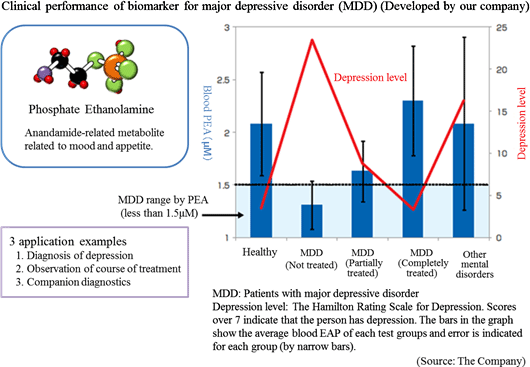 *Companion diagnostics: Refers to clinical tests to predict effects and side effects of pharmaceutical products before administration. By checking the responses of individual patient towards a drug before treatment, more effective drug administration can be provided.
◎Identification of disease biomarkers
The Company uses the following three connections and systems for identifying biomarkers in order to expand biomarker development pipelines.
<Connection with the customers for commissioned analysis or collaborative development>
The Company accepts requests from universities and companies for the tests for finding biomarkers. The Company also receives proposals for collaborative development before or after the tests. Currently, it is working on collaborative development for diabetic nephropathy biomarkers. <Direct proposal to researchers and physicians>
The Company's researchers propose research plans for the development of disease biomarkers directly to the researchers or physicians, and conduct tests based on approval from the collaborative researchers or physicians and collaborative study agreement with the institution that the researchers or physicians belong to. The target diseases are chosen based on the number of patients, characteristics of the analysis technologies of the Company, degree of social contribution, and necessity of biomarkers. In addition to major depressive disorder, the Company is working on the development of biomarkers for non-alcoholic steatohepatitis and fibromyalgia.
<Leading metabolomics research support system>
The Company offers the metabolomics research grant (HMT Research Grant for Young Leaders in Metabolomics) to graduate students to disseminate the usefulness of metabolomics in the society and develop young researchers. From the research themes proposals submitted from graduate students across the world, the Company chooses excellent proposals and supports their research by giving metabolomics results without fees. Fourteen students have been awarded in the last 4 years. Some of these study results actually led to identification of biomarkers and evolved to collaborative study with the Company, an example of which was infectious disease-related encephalopathy biomarker.
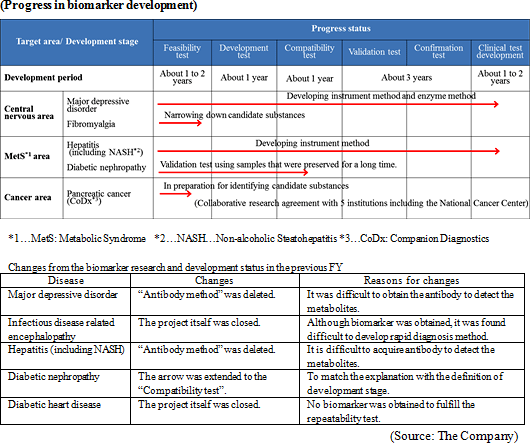 |
| Fiscal Year March 2015 Earnings Results |
 Despite increase in sales, deficit increased mainly due to increase in personnel for future growth
Sales during FY March 2015 were ¥686 million, up 12.5% YoY. Although the metabolomics business continued to show steady growth, it did not make up for the cost to increase manpower (i.e. sales staff and staff for each business segment) for business expansion and facility investment for the biomarker business. As a result, it ran a larger deficit as compared with the previous FY. Sales and income went below the planned figures, because a large-scale project for the metabolomics business was not completed as planned in the previous FY.
  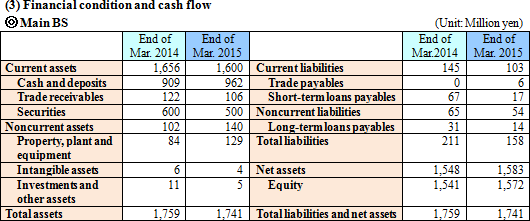 The Company's financial status is very healthy. To the Company, it is important to find a balanced way of utilizing the cash (close to ¥1 billion) in order to contribute to the society and respond to the expectations from the investors.  The negative gap of investing CF increased as a result of increase in acquisition cost of property, plant and equipment. This is the same for free CF. Financing CF turned into negative due to decrease in revenue by issuing shares as a result of exercising equity warrant. Cash position has declined. |
| Fiscal Year March 2016 Earnings Estimates |
 Increase in sales/ returning to profit
Sales for FY March 2016 are expected to be ¥900 million, up 30% YoY. It is expecting to obtain more large-scale projects for the metabolomics business. It will continue to invest in growth by increasing manpower and focusing on research and development. It is planning to increase sales and profit for the metabolomics business and reduce loss for the biomarker business to return to profitability. 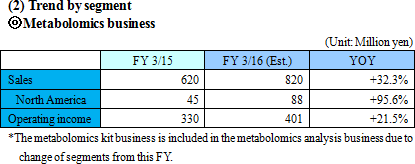 External environment looks good
In association with the enforcement of the new Food Functionality Labeling System (*), it is expected that the demand for metabolomics by the companies that need analysis results will increase. The budget in the field of studies on food and health for health and longevity and preventive medicine is also increasing. Furthermore, the systems to support new drug creation and promote development of innovative drugs are being established such as launch of "Japan Agency for Medical Research and Development". (*) In addition, in the field of cancer research, the cancer research budget in the US is approximately 18 times larger than that of Japan, and the room for market development for the Company's analysis service for cancer research, "C-SCOPE", is very large. Thus, the external environment for the business is good. *New Food Functionality Labeling System The System was established in June 2013 as a part of relaxation of regulations in the Japan Revitalization Strategy. The purposes of the System are "to provide appropriate information for the public to protect their own health and to establish systems to promote functional display that are simpler than the labeling of the foreign countries, taking into consideration overseas expansion of agricultural products". This category was established following the existing categories, Food for Specified Uses, and Food for Nutrient Function Claims. If products pass certain conditions such as safety and functionality, the companies or producers can label "its health effects" and "its functionality". In order to acquire authorization to label Food for Specified Uses, the products need to go through clinical tests, which is a burden to the companies and producers in terms of cost and time. On the other hand, the new System requires companies only to submit the systematic review of food or functionality-related components. *Japan Agency for Medical Research and Development Based on the "Plan for Promotion of Medical Research and Development", the Japan Agency for Medical Research and Development was launched to accelerate application of the basic research results in the field of drugs and medical equipment with a focus on nine fields including regenerative medicine, cancer, and cognitive impairment and to achieve the world's highest standard of treatment technologies. The Agency manages more than some ¥140 billion funded by the Ministry of Education, Culture, Sports, Science and Technology, the Ministry of Health, Labor and Welfare, and the Ministry of Economy, Trade and Industry and distributes the funds strategically to the researchers. Future actions
The Company will continue to strengthen its sales system. In the previous FY, the Company hired 11 additional excellent employees with new skills. During the current FY, the Company will employ sales personnel for Asia in an effort to expand its market in Asia. During the current FY, it will also organize many seminars in collaboration with sales department and academic department, in order to enhance visibility and facilitate understanding as well as to obtain large-scale projects and comprehensive contracts. In the US, the Company will make efforts to enhance visibility with a focus on priority areas and expand the sales of "C-SCOPE". Furthermore, it will try to enhance profitability by improving productivity of analytical work.  Development of blood markers for depression diagnostic kit
As previously described, the milestone that the Company was aiming to achieve during the previous FY has been delayed for about half a year. During the first quarter of this FY, the Company will try to solve technical problems with its collaborative research partner, Sysmex Corporation, and during the second quarter of this FY, which is the priority negotiation period for licensing, it will begin license negotiation. This way, the Company will ensure to achieve the milestone during the current FY. Formation of revenue base by expanding clinical tests for depression
In the previous FY, the Company began to conduct clinical tests for depression in cooperation with a specialized hospital in order to increase recognition on depression biomarkers and expand its business opportunities for fee-based tests for major depressive disorder. Currently, the Company receives blood samples from Toyoko Keiai Hospital through the Health Science Research Institute and measures the biomarkers using the ion chromatography analysis method. After the test, the report is sent to Toyoko Keiai Hospital through the Health Science Research Institute. The Company is aiming to expand this kind of business activities in order to have more solid revenue base. Organization of development structure for more businesses
The Company will continue to proactively make investment for future growth.
|
| Conclusions |
|
A particularly notable progress was to have acquired excellent employees. They sought employment at the Company due in part to its increased credibility as a result of becoming a public company. Nonetheless, the stock market continues to give a harsh assessment because the Company has not achieved its milestone (e.g. development of major depressive disorder biomarker enzymatic test kit) that was expected to achieve during the last FY. Under this circumstance, at what point the Company achieves its first milestone is the key point of interest. Disclaimer
This report is intended solely for information purposes, and is not intended as a solicitation for investment. The information and opinions contained within this report are made by our company based on data made publicly available, and the information within this report comes from sources that we judge to be reliable. However we cannot wholly guarantee the accuracy or completeness of the data. This report is not a guarantee of the accuracy, completeness or validity of said information and opinions, nor do we bear any responsibility for the same. All rights pertaining to this report belong to Investment Bridge Co., Ltd., which may change the contents thereof at any time without prior notice. All investment decisions are the responsibility of the individual and should be made only after proper consideration.Copyright(C) 2015 Investment Bridge Co., Ltd. All Rights Reserved. |

